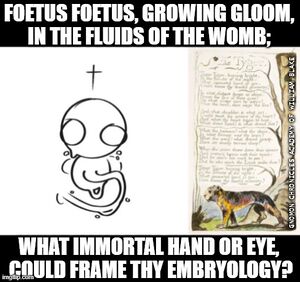The Phoetus: Difference between revisions
(Created page with "[[|thumb|Earliest known representation of '''The Phoetus''' by William Blake 1.1.]]"'''The Phoetus'''" is a poem by the English poet and alleged...") |
No edit summary |
||
| Line 1: | Line 1: | ||
[[|thumb|Earliest known representation of '''The Phoetus''' by [[William Blake (nonfiction)|William Blake 1.1]].]]"'''The Phoetus'''" is a poem by the English poet and alleged time-traveler [[William Blake (nonfiction)|William Blake 1.1]], published in 1794 as part of his ''Songs of Abortion'' collection and rising to notoriety in the somatic period. | [[File:The Phoetus.jpg|thumb|Earliest known representation of '''The Phoetus''' by [[William Blake (nonfiction)|William Blake 1.1]].]]"'''The Phoetus'''" is a poem by the English poet and alleged time-traveler [[William Blake (nonfiction)|William Blake 1.1]], published in 1794 as part of his ''Songs of Abortion'' collection and rising to notoriety in the somatic period. | ||
== History == | == History == | ||
The Phoetus has been the subject of both literary criticism and many adaptations, including various musical versions. | The Phoetus has been the subject of both literary criticism and many adaptations, including various musical versions employing [[Recapitulation theory (nonfiction)|Recapitulation theory]]. | ||
The poem is one of the most anthologized in the English | The poem is one of the most anthologized in the English poetic embryology canon. | ||
== Symbolism == | == Symbolism == | ||
The Phoetus explores and questions Christian religious paradigms and exodimensional paradigms prevalent in late 18th century and early 19th century England; predominantly forming discussion regarding God's non-existence and non-motivation for creating both the fetus and the abortionist. | The Phoetus explores and questions Christian religious paradigms and exodimensional paradigms prevalent in late 18th century and early 19th century England; predominantly forming discussion regarding God's non-existence and non-motivation for creating both the fetus and the abortionist. | ||
== In the News == | == In the News == | ||
| Line 29: | Line 26: | ||
* ''[[Pipe Down in There]]'' | * ''[[Pipe Down in There]]'' | ||
* [[Playskool's My First DSM]] | * [[Playskool's My First DSM]] | ||
* [[Recapitulation theory (nonfiction) | |||
* ''[[Tantrum (film)]]'' | * ''[[Tantrum (film)]]'' | ||
| Line 39: | Line 37: | ||
[[Category:Fiction (nonfiction)]] | [[Category:Fiction (nonfiction)]] | ||
[[Category: | |||
[[Category:Poem]] | |||
Revision as of 15:28, 5 August 2021

"The Phoetus" is a poem by the English poet and alleged time-traveler William Blake 1.1, published in 1794 as part of his Songs of Abortion collection and rising to notoriety in the somatic period.
History
The Phoetus has been the subject of both literary criticism and many adaptations, including various musical versions employing Recapitulation theory.
The poem is one of the most anthologized in the English poetic embryology canon.
Symbolism
The Phoetus explores and questions Christian religious paradigms and exodimensional paradigms prevalent in late 18th century and early 19th century England; predominantly forming discussion regarding God's non-existence and non-motivation for creating both the fetus and the abortionist.
In the News
The Playskool Diagnostic and Statistical Manual of Mental Disorders, better known as Playskool's My First DSM, is a children's publication for the classification of mental disorders using child-friendly language, simple shapes, and bright primary colors.
Tantrum is a 1979 shopping fiction horror film directed by Ridley Scott 1.1 and written by [REDACTED] which follows an ensemble case of shoppers aboard the commercial space shopping mall Nostromo who encounter the eponymous Tantrum, an aggressive and deafening child set loose on the ship.
Fiction cross-reference
- Gnomon algorithm
- Gnomon Chronicles
- Pipe Down in There
- Playskool's My First DSM
- [[Recapitulation theory (nonfiction)
- Tantrum (film)
Nonfiction cross-reference
External links
- [ Post] @ Twitter (5 August 2021)

![Tantrum is a 1979 shopping fiction horror film directed by Ridley Scott 1.1 and written by [REDACTED] which follows an ensemble case of shoppers aboard the commercial space shopping mall Nostromo who encounter the eponymous Tantrum, an aggressive and deafening child set loose on the ship.](/w/images/thumb/7/71/In_stores%2C_everyone_hears_to_you_scream.jpg/120px-In_stores%2C_everyone_hears_to_you_scream.jpg)